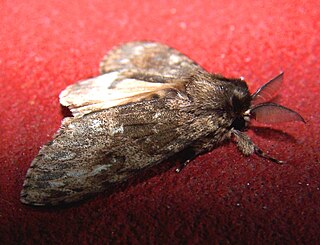
Nepita is a monotypic moth genus in the subfamily Arctiinae described by Moore in 1860. Its only species, Nepita conferta, the footman moth, was first described by Francis Walker in 1854. It is found in India and Sri Lanka.

Yepcalphis is a monotypic moth genus of the family Noctuidae erected by Nye in 1975. Its only species, Yepcalphis dilectissima, was first described by Francis Walker in 1858. It is found in Sri Lanka, the Oriental tropics, the Philippines, Sulawesi and the Sula Islands.

Calyptra minuticornis, the vampire moth, is a moth of the family Erebidae. It has been found in Indonesia, Java, India, Sri Lanka, and Australasia.
Ancylolomia chrysographellus, the angled grass moth, is a species of moth in the family Crambidae. It is found on Cyprus and in Kenya, Uganda, Yemen, India, Pakistan, Sri Lanka, Myanmar, China, Korea, Japan, Taiwan, the Philippines and Indonesia.

Amyna punctum is a moth of the family Noctuidae first described by Johan Christian Fabricius in 1794. This moth can be found throughout subtropical African countries such as South Africa, Madagascar and Australasian countries like India, Sri Lanka, the Philippines, Borneo and the Andaman Islands.
Somatina omicraria is a moth of the family Geometridae first described by Johan Christian Fabricius in 1798. It is found in India and Sri Lanka.
Somatina purpurascens is a moth of the family Geometridae first described by Frederic Moore in 1887. It is found in Sri Lanka.

Lymantria serva, the ficus tussock moth or serva tussock moth, is a moth in the family Erebidae. It was described by Johan Christian Fabricius in 1793 and is found in Nepal, Sri Lanka, Assam in India and Yunnan in China. It is possibly also found in Taiwan and Hongkong, but these records might be Lymantria iris.

Asura arcuata is a moth of the family Erebidae. It was described by Frederic Moore in 1882. It is found in India, Indonesia, Taiwan and Japan.
Asura rubricosa is a moth of the family Erebidae. It is found in India and Sri Lanka.
Asura floccosa is a moth of the family Erebidae. It is found in India and Sri Lanka.
Asura ila is a moth of the family Erebidae. It is found in India and Sri Lanka.
Asura quadrilineata is a moth of the family Erebidae. It is found on Aru and in Australia.
Asura ruptifascia is a moth of the family Erebidae. It is found in India and Sri Lanka.
Asura solita is a moth of the family Erebidae. It is found in Sri Lanka.
Asura uniformis is a moth of the family Erebidae. It is found in Sri Lanka.
Asura varians is a moth of the family Erebidae. It is found in Sri Lanka.

Athetis reclusa is a moth of the family Noctuidae first described by Francis Walker in 1862. It is found from Sundaland to New Caledonia and Fiji. The habitat consists of open areas from sea level up to 1,200 meters.
Spilarctia castanea is a moth in the family Erebidae. It was described by George Hampson in 1893. It is found in Sri Lanka.
Donacaula dodatellus is a moth in the family Crambidae. It was described by Francis Walker in 1864. It is found in China (Yunnan), Japan, India, Myanmar, Sri Lanka, the Philippines and on Sumatra.






